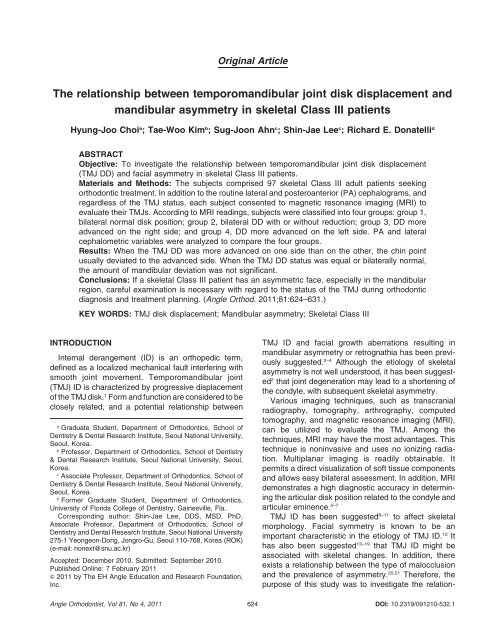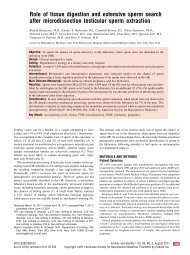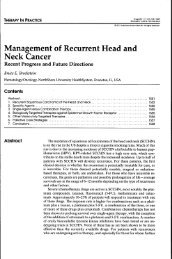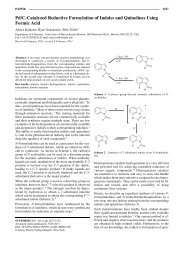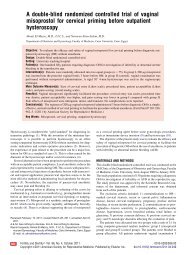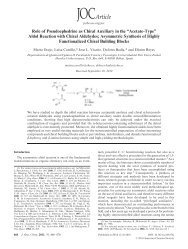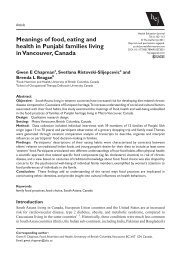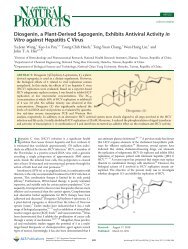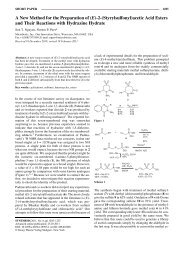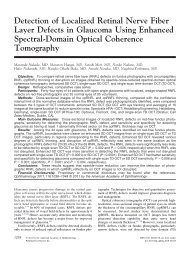PDF (396 KB) - The Angle Orthodontist
PDF (396 KB) - The Angle Orthodontist
PDF (396 KB) - The Angle Orthodontist
Create successful ePaper yourself
Turn your PDF publications into a flip-book with our unique Google optimized e-Paper software.
Original Article<br />
<strong>The</strong> relationship between temporomandibular joint disk displacement and<br />
mandibular asymmetry in skeletal Class III patients<br />
Hyung-Joo Choi a ; Tae-Woo Kim b ; Sug-Joon Ahn c ; Shin-Jae Lee c ; Richard E. Donatelli d<br />
ABSTRACT<br />
Objective: To investigate the relationship between temporomandibular joint disk displacement<br />
(TMJ DD) and facial asymmetry in skeletal Class III patients.<br />
Materials and Methods: <strong>The</strong> subjects comprised 97 skeletal Class III adult patients seeking<br />
orthodontic treatment. In addition to the routine lateral and posteroanterior (PA) cephalograms, and<br />
regardless of the TMJ status, each subject consented to magnetic resonance imaging (MRI) to<br />
evaluate their TMJs. According to MRI readings, subjects were classified into four groups: group 1,<br />
bilateral normal disk position; group 2, bilateral DD with or without reduction; group 3, DD more<br />
advanced on the right side; and group 4, DD more advanced on the left side. PA and lateral<br />
cephalometric variables were analyzed to compare the four groups.<br />
Results: When the TMJ DD was more advanced on one side than on the other, the chin point<br />
usually deviated to the advanced side. When the TMJ DD status was equal or bilaterally normal,<br />
the amount of mandibular deviation was not significant.<br />
Conclusions: If a skeletal Class III patient has an asymmetric face, especially in the mandibular<br />
region, careful examination is necessary with regard to the status of the TMJ during orthodontic<br />
diagnosis and treatment planning. (<strong>Angle</strong> Orthod. 2011;81:624–631.)<br />
KEY WORDS: TMJ disk displacement; Mandibular asymmetry; Skeletal Class III<br />
INTRODUCTION<br />
Internal derangement (ID) is an orthopedic term,<br />
defined as a localized mechanical fault interfering with<br />
smooth joint movement. Temporomandibular joint<br />
(TMJ) ID is characterized by progressive displacement<br />
of the TMJ disk. 1 Form and function are considered to be<br />
closely related, and a potential relationship between<br />
a Graduate Student, Department of Orthodontics, School of<br />
Dentistry & Dental Research Institute, Seoul National University,<br />
Seoul, Korea.<br />
b Professor, Department of Orthodontics, School of Dentistry<br />
& Dental Research Institute, Seoul National University, Seoul,<br />
Korea.<br />
c Associate Professor, Department of Orthodontics, School of<br />
Dentistry & Dental Research Institute, Seoul National University,<br />
Seoul, Korea.<br />
d Former Graduate Student, Department of Orthodontics,<br />
University of Florida College of Dentistry, Gainesville, Fla.<br />
Corresponding author: Shin-Jae Lee, DDS, MSD, PhD,<br />
Associate Professor, Department of Orthodontics, School of<br />
Dentistry and Dental Research Institute, Seoul National University<br />
275-1 Yeongeon-Dong, Jongro-Gu, Seoul 110-768, Korea (ROK)<br />
(e-mail: nonext@snu.ac.kr)<br />
Accepted: December 2010. Submitted: September 2010.<br />
Published Online: 7 February 2011<br />
G 2011 by <strong>The</strong> EH <strong>Angle</strong> Education and Research Foundation,<br />
Inc.<br />
<strong>Angle</strong> <strong>Orthodontist</strong>, Vol 81, No 4, 2011<br />
624<br />
TMJ ID and facial growth aberrations resulting in<br />
mandibular asymmetry or retrognathia has been previously<br />
suggested. 2–4 Although the etiology of skeletal<br />
asymmetry is not well understood, it has been suggested<br />
2 that joint degeneration may lead to a shortening of<br />
the condyle, with subsequent skeletal asymmetry.<br />
Various imaging techniques, such as transcranial<br />
radiography, tomography, arthrography, computed<br />
tomography, and magnetic resonance imaging (MRI),<br />
can be utilized to evaluate the TMJ. Among the<br />
techniques, MRI may have the most advantages. This<br />
technique is noninvasive and uses no ionizing radiation.<br />
Multiplanar imaging is readily obtainable. It<br />
permits a direct visualization of soft tissue components<br />
and allows easy bilateral assessment. In addition, MRI<br />
demonstrates a high diagnostic accuracy in determining<br />
the articular disk position related to the condyle and<br />
articular eminence. 5–7<br />
TMJ ID has been suggested 8–11 to affect skeletal<br />
morphology. Facial symmetry is known to be an<br />
important characteristic in the etiology of TMJ ID. 12 It<br />
has also been suggested 13–19 that TMJ ID might be<br />
associated with skeletal changes. In addition, there<br />
exists a relationship between the type of malocclusion<br />
and the prevalence of asymmetry. 20,21 <strong>The</strong>refore, the<br />
purpose of this study was to investigate the relation-<br />
DOI: 10.2319/091210-532.1
TMJ DISK DISPLACEMENT AND MANDIBULAR ASYMMETRY 625<br />
ships between TMJ ID and facial asymmetry using<br />
MRI readings in skeletal Class III patients.<br />
MATERIALS AND METHODS<br />
<strong>The</strong> subject population comprised adult patients with<br />
skeletal Class III malocclusion who visited the Department<br />
of Orthodontics at Seoul National University<br />
Dental Hospital for orthodontic treatment during the<br />
2000–2005 period. Before orthodontic treatment, we<br />
recommended that patients with skeletal Class III<br />
malocclusion have a TMJ MRI performed, regardless<br />
of their symptoms or facial asymmetry. This random<br />
subject collection was based on the Poisson sampling<br />
model without fixing the total sample size. Ninetyseven<br />
patients (60 females and 37 males) with a mean<br />
age of 22.1 years agreed and became our subjects.<br />
<strong>The</strong> criteria for selecting the patients were that they<br />
were nongrowing adults with a skeletal Class III<br />
malocclusion (assessed by ANB, Wits appraisal, and<br />
mandibular body length), had at least one molar<br />
relationship showing Class III <strong>Angle</strong> classification,<br />
and had no obvious health problems, trauma, or<br />
growth disturbances. <strong>The</strong> institutional review board at<br />
this university was not instituted until 2005. Hence, we<br />
could not obtain institutional approval for this project.<br />
MRIs were obtained using a Signa Horison (GE,<br />
Waukesha, Wis) operating at 1.5 T and a unilateral 3inch<br />
surface receiver coil. Closed-mouth images were<br />
obtained at maximum dental intercuspation, and openmouth<br />
images were taken at maximum unassisted<br />
vertical mandibular opening using a Burnett bidirectional<br />
TMJ device (Medrad, Pittsburgh, Pa). <strong>The</strong><br />
images were interpreted by a radiologist. <strong>The</strong> subjects<br />
were divided according to the MRI status of both of<br />
their TMJs into the four following groups (Figure 1):<br />
group 1: normal disk position in both TMJs; group 2:<br />
disk displacement (DD) with reduction (DDR) in both<br />
TMJs or DD without reduction (DDNR) in both TMJs;<br />
group 3: the TMJ ID was more advanced on the right<br />
side (ie, when the left TMJ was normal and the right<br />
TMJ showed DDR or DDNR or when the left TMJ was<br />
DDR and the right TMJ showed DDNR); and group 4:<br />
the TMJ ID was more advanced on the left side (ie,<br />
when the right condyle was normal and the left condyle<br />
showed DDR or DDNR or when the right condyle was<br />
DDR and left condyle showed DDNR).<br />
Posteroanterior (PA) and lateral cephalograms of<br />
each patient (taken with teeth in habitual maximum<br />
intercuspation and lips in repose with a magnification<br />
ratio of 1:1) were traced by one of the authors. <strong>The</strong><br />
tracings were then digitized and analyzed. For the<br />
lateral cephalometric radiograph, 11 linear, seven<br />
angular, and three proportional measurements were<br />
analyzed for the lateral cephalometric evaluation of the<br />
cranial base, maxilla, mandible, antero-posterior relationships,<br />
and vertical relationships (Figure 2).<br />
To evaluate the facial asymmetry, the landmarks on<br />
the PA cephalogram were identified with the methods<br />
recommended by Sassouni 22 and Ricketts et al. 23<br />
(Figure 3). According to methods outlined in previous<br />
studies, 22,24,25 the facial midline was defined as a line<br />
perpendicular to the line connecting Lo and Lo9<br />
through Nc. When the landmark was located left of<br />
the midline, a positive value was assigned.<br />
One-way analysis of variance and Scheffè multiple<br />
comparisons was utilized to compare the four groups.<br />
Relative risk ratio was calculated to measure how<br />
much facial asymmetry influenced the risk of asymmetric<br />
DD.<br />
RESULTS<br />
<strong>The</strong> distribution of subjects according to TMJ MRI<br />
reading, gender, and mean age of each group is<br />
summarized in Table 1. Sixty percent of subjects had<br />
DDR or DDNR in at least one of their TMJs, and 40% of<br />
subjects showed normal disk status (Table 2). Out of<br />
194 total TMJs, 75 TMJs (38.7%) had DDR or DDNR.<br />
Among the 97 patients, 63 patients had TMJ symptoms,<br />
which showed no statistically significant difference<br />
between the MRI findings. <strong>The</strong> most frequent symptom<br />
for each TMJ was ‘‘TMJ sounds only’’ (40–50%),<br />
followed by ‘‘both pain and sounds’’ (24–30%) (Table 3).<br />
Although there were few differences in the lateral<br />
cephalometric variables, including FMA, facial height<br />
ratio, and mandibular incisor to FH plane, the Scheffè’s<br />
multiple comparisons did not indicate statistical significance<br />
(Table 4).<br />
Table 5 reports the comparisons of the PA cephalometric<br />
variables among the four groups. <strong>The</strong> linear<br />
measurements evaluating the amount of maxillary<br />
asymmetry (ANS-Mid and U1-Mid) were not significant.<br />
However, the linear variables evaluating the<br />
amount of mandibular asymmetry (L1-Mid and Men-<br />
Mid) did show significant differences. Since a positive<br />
sign indicates that the landmark was located left of the<br />
midline, the results demonstrate that there was a rightsided<br />
mandibular shift in group 3 and a left-sided<br />
mandibular shift in group 4.<br />
To eliminate the effect of positive and negative signs<br />
and to concentrate on the quantitative comparison, the<br />
absolute values of each variable were taken and<br />
compared. Comparisons of the absolute value of linear<br />
measurements also demonstrated statistical significance<br />
at L1-Mid and Men-Mid. This indicates that the<br />
absolute amount of mandibular asymmetry was<br />
greater in groups 3 and 4 than in groups 1 and 2.<br />
<strong>The</strong> angular measurement that evaluates vertical<br />
asymmetry demonstrated that all of the variables<br />
<strong>Angle</strong> <strong>Orthodontist</strong>, Vol 81, No 4, 2011
626 CHOI, KIM, AHN, LEE, DONATELLI<br />
Figure 1. Temporomandibular joint (TMJ) magnetic resonance imaging (MRI) images: left, closed mouth; right, open mouth. Top, normal status;<br />
middle, anterior disk displacement with reduction; bottom, anterior disk displacement without reduction.<br />
(FMxP, FOP, and FMdP) resulted in statistical<br />
differences. However, in the comparisons of the<br />
absolute value of angular measurements, only FMdP<br />
was statistically significant.<br />
<strong>The</strong> relative risks for the amount of mandibular<br />
deviation were calculated by comparing groups 3 and<br />
<strong>Angle</strong> <strong>Orthodontist</strong>, Vol 81, No 4, 2011<br />
4 to groups 1 and 2 (Table 6). <strong>The</strong> relative risk of<br />
groups 3 and 4 over groups 1 and 2 for the deviation of<br />
menton more than 3 mm was 2.26. For the deviation of<br />
the midline of the lower incisors more than 2 mm, the<br />
relative risk was 1.93. For a FMdP angle of greater<br />
than 3u, the relative risk was 2.27.
TMJ DISK DISPLACEMENT AND MANDIBULAR ASYMMETRY 627<br />
Figure 2. Lateral cephalometric analysis. Left, lateral cephalometric landmarks: 1, sella; 2, nasion; 3, orbitale; 4, porion; 5, articulare; 6, gonion;<br />
7, anterior nasal spine; 8, posterior nasal spine; 9, subspinale; 10, supramentale; 11, pogonion; 12, menton: 13, crown tip of upper central incisor;<br />
14, crown tip of lower central incisor. Middle, linear measurement of lateral cephalometry: 1, S-N; 2, S-Ar; 3, Pog to N perpendicular; 4, Wits<br />
appraisal; 5, anterior facial height (N-Me); 6, posterior facial height angle (S-Go); 7, ramus height (Ar-Go); 8, mandibular body length (Go-Me).<br />
Right, angular measurements: 1, SNA angle; 2, SNB angle; 3, ANB; 4, FMA; 6, SN to mandibular plane angle; 7, FH to palatal plane angle; 7,<br />
articular angle; 8, mandibular incisor to FH plane; 9, gonial angle.<br />
DISCUSSION<br />
<strong>The</strong>re have been a number of studies that have<br />
attempted to correlate temporomandibular disease<br />
(TMD) and skeletal morphology, especially with regard<br />
to facial asymmetry. Most previous studies included<br />
patients with TMD symptoms or facial asymmetry but<br />
did not focus on specific skeletal features. Our study<br />
randomized skeletal Class III patients with and without<br />
TMD symptoms or asymmetry and analyzed features<br />
of lateral and PA cephalograms in combination with<br />
MRI readings.<br />
<strong>The</strong>re are a number of causes for facial asymmetry<br />
as well as for TMJ DD. Thus, it is difficult to describe<br />
the clear cause and effect between them. However, to<br />
date the data indicate that facial asymmetry, especially<br />
mandibular asymmetry, can influence the shape and<br />
function of the TMJ and vice versa. In other words,<br />
TMJ DD can be the cause of facial asymmetry. 13,14,26,27<br />
If DD becomes progressive, it might cause bony<br />
Figure 3. Posteroanterior (PA) cephalometric analysis. Left, PA cephalometric landmarks: Lo, bilateral intersection of the oblique orbital line with<br />
the lateral contour of the right and left side orbits; Nc, neck of crista galli; ANS, anterior nasal spine; Me, menton; J, jugal process of the maxilla at<br />
a crossing with the tuberosity of the maxilla; Ag, the highest point in the antegonial notch; U1, mesial contact point of upper central incisors at the<br />
level of gingival crest; L1, mesial contact points of lower incisors at the level of gingival crest; U6, the buccal-most point on the crown of the upper<br />
first molar; L6, the buccal-most point on the crown of the lower first molar. Middle, PA linear measurements: ANS-Mid, horizontal distance from<br />
vertical reference line to ANS; U1-Mid, horizontal distance from vertical reference line to U1; L1-Mid, horizontal distance from vertical reference<br />
line to L; Men-Mid, horizontal distance from vertical reference line to menton. Right, PA angular measurements: FMxP, frontal maxillary plane<br />
angle; FOP, frontal occlusal plane angle; FMdP, frontal mandibular plane angle.<br />
<strong>Angle</strong> <strong>Orthodontist</strong>, Vol 81, No 4, 2011
628 CHOI, KIM, AHN, LEE, DONATELLI<br />
Table 1. Distribution of Subjects a<br />
Gender<br />
Group 1 Group 2 Group 3 Group 4 Total<br />
Male 15 5 10 7 37<br />
Female 24 5 15 16 60<br />
Total 39 10 25 23 97<br />
Age, y b 22.262.9 20.864.1 22.864.5 21.662.5 22.163.5<br />
a Group 1, normal disk position in both TMJs; Group 2, disk displacement with reduction in both TMJs or without reduction in both TMJs; Group<br />
3, the TMJ internal derangement (ID) was more advanced on the right side (ie, when the left TMJ was normal and right TMJ showed disk<br />
displacement with reduction [DDR] or DD without reduction [DDNR] or when the left TMJ was DDR and the right TMJ showed DDNR); Group 4,<br />
the TMJ ID was more advanced on the left side (ie, when the right condyle was normal and the left condyle showed DDR or DDNR or when the<br />
right condyle was DDR and left condyle showed DDNR).<br />
b Values indicate mean6standard deviation.<br />
changes. 28 An irregularly shaped right or left joint can<br />
also easily cause a problem. 29 This was proven in a<br />
previous study 18 using finite element analysis. <strong>The</strong>refore,<br />
facial asymmetry associated with TMJ DD may<br />
be due to osseous changes in the condylar head by<br />
TMJ DD. Previous studies 30,31 have reported bony<br />
changes on the articular surface of the mandibular<br />
condyle in patients with TMJ DD, specifically a<br />
decreased condylar height with a distally inclined<br />
condylar head. <strong>The</strong> changes in the shape and size of<br />
the mandibular condyle may induce mandibular shortening<br />
of the DD side, namely mandibular asymmetry<br />
and facial asymmetry.<br />
In this study, the manifest site and degree of TMJ<br />
DD correlated more with facial asymmetry in the<br />
mandible than in the maxilla. <strong>The</strong> variables evaluating<br />
the maxillary asymmetry did not demonstrate a<br />
significant difference between the groups. This may<br />
indicate that the basic cause for asymmetry in skeletal<br />
Class III malocclusions lies in the mandible (Table 5).<br />
Class III often reoccurs after Class III surgery. <strong>The</strong><br />
reoccurrence might be related to the fact that Class III<br />
malocclusion may sometimes represent progressive<br />
condylar hyperplasias, some bilateral and some<br />
unilateral or DD on one side, possibly affecting growth,<br />
and sometimes bilateral.<br />
In the mandible, the deviation of mandibular menton<br />
and the frontal mandibular plane angle showed clear<br />
Table 2. Cross-Table of Temporomandibular Joint (TMJ) Magnetic<br />
Resonance Imaging (MRI) Results a<br />
Right TMJ MRI<br />
Left TMJ MRI<br />
Normal DDR DDNR<br />
Total<br />
Normal, n (%) 39 (40.2) 17 (17.5) 3 (3.1) 59 (60.8)<br />
DDR, n (%) 15 (15.5) 9 (9.3) 3 (3.1) 27 (27.9)<br />
DDNR, n (%) 6 (6.2) 4 (4.1) 1 (1.0) 11 (11.3)<br />
Total 60 (61.9) 30 (30.9) 7 (7.2) 97 (100)<br />
a Normal indicates normal TMJ disk position; DDR, disk displacement<br />
with reduction; and DDNR, DD without reduction. Fisher Exact<br />
test for count data indicated no significant difference in the<br />
prevalence between the MRI findings.<br />
<strong>Angle</strong> <strong>Orthodontist</strong>, Vol 81, No 4, 2011<br />
differences between the groups. In the group showing<br />
normal or identical conditions of DD in both TMJs<br />
(groups 1 and 2), the asymmetry of the mandible was<br />
not significant. However, when one of the TMJs with<br />
DD, either right or left, was more advanced on one side<br />
than on the other side, the mandible was shifted toward<br />
the side with greater DD. This indicates that TMJ DD<br />
showed laterality, and its direction was in accordance<br />
with the side with the shifted midline. <strong>The</strong> mandible has<br />
a positive or negative sign indicating the direction of the<br />
deviation. Calculating the average midline displacement<br />
can offset this sign. <strong>The</strong>refore, if the direction of the<br />
deviation (6 sign from Table 5) is not considered when<br />
calculating the real displacement, a significant difference<br />
in the horizontal deviation of the midline of the<br />
lower incisors, menton, and the frontal mandibular plane<br />
angle is also observed. This calculation demonstrated<br />
that the side with the more advanced TMJ DD was also<br />
the shifted side of the mandible.<br />
In a previous study 32 of skeletal Class I and II<br />
malocclusion patients, the research on lateral cephalograms<br />
demonstrated significant differences in<br />
terms of facial height ratio, ramus height, and position<br />
of the mandible between a normal group and a group<br />
having bilateral DD. However, our study did not<br />
show a significant difference. It is possible that the<br />
relation between TMJ DD and skeletal morphology is<br />
influenced in different ways by differences in skeletal<br />
pattern. For example, in the skeletal Class II<br />
malocclusion, TMJ DD mainly influences the TMJ<br />
bilaterally, resulting in mandibular clockwise rotation,<br />
an anterior open bite, and a large overjet. 32 On the<br />
other hand, in the cases of patients with skeletal<br />
Class III malocclusion and facial asymmetry, the TMJ<br />
on the shifted side of the mandible entailed an<br />
extreme prevalence of DD.<br />
According to the degree of mandibular asymmetry<br />
and the relative risk of groups 3 and 4 over groups 1<br />
and 2 (Table 6), patients who demonstrated more than<br />
3 mm or 3u of asymmetry had a greater probability of<br />
having different levels of TMJ DD on each side. On the
TMJ DISK DISPLACEMENT AND MANDIBULAR ASYMMETRY 629<br />
Table 3. Distribution of Temporomandibular Joint (TMJ) Symptoms and Magnetic Resonance Imaging (MRI) Findings a<br />
contrary, patients with relatively little asymmetry fell<br />
into the normal TMJ group or the bilateral TMJ DD<br />
group. <strong>The</strong>refore, the results of this study indicate that<br />
if either the left or right TMJ has greater DD than the<br />
opposite side, the mandibular displacement will be<br />
seen on the more advanced side. If both TMJs are<br />
normal or have the same amount of DD, the facial<br />
asymmetry is not outstanding.<br />
It is necessary to discriminate the latent TMJ DD<br />
patients during the orthodontic diagnosis and to make<br />
them aware of their preexisting condition before<br />
initiating treatment. In reality, TMJ DD may be less<br />
Table 4. Comparison of Lateral Cephalometric Variables a<br />
Variables<br />
Cranial base relationships<br />
Group 1<br />
(n 5 39)<br />
Group 2<br />
(n 5 10)<br />
related to unwanted signs and symptoms than has<br />
been previously postulated. 17,27,33 According to the<br />
results of this study’s skeletal Class III mandibular<br />
asymmetrical patients, we can infer that both the<br />
frontal mandibular plane angle (which indicates the<br />
horizontal asymmetry of the mandible) and the<br />
horizontal deviation of the lower incisor (measured<br />
from the vertical reference line) indicate the possibility<br />
of advanced TMJ DD on the side of mandibular<br />
displacement. Another possibility is that both joints<br />
may have DD to the same degree when the<br />
mandibular asymmetry is not prominent.<br />
Group 3<br />
(n 5 25)<br />
Group 4<br />
(n 5 23)<br />
Anterior cranial base length, mm 69.763.3 70.663.5 69.464.6 69.063.6 NS<br />
Posterior cranial base length, mm 37.064.1 37.064.0 36.864.7 37.264.4 NS<br />
Maxillomandibular relationships<br />
SNA angle, u 81.263.8 81.564.4 80.364.1 80.564.7 NS<br />
SNB angle, u 84.764.6 83.163.4 83.165.2 82.464.8 NS<br />
Pog to N perpendicular, mm 8.268.2 3.068.6 5.368.8 3.668.3 NS<br />
ANB angle, u 23.562.7 21.662.7 22.963.5 22.063.2 NS<br />
Wits appraisal, mm 11.866.0 29.365.0 214.2610.6 210.664.4 NS<br />
Vertical skeletal relationship<br />
Significance<br />
Multiple<br />
Comparison b<br />
Gonial angle, u 124.567.8 127.665.4 147.566.5 147.266.9 NS<br />
FMA, u 25.366.5 28.663.7 28.866.4 29.164.9 * NS<br />
SN to mandibular plane angle, u 33.867.2 37.564.3 37.668.1 37.965.7 NS<br />
FH to palatal plane angle, u 0.963.4 1.363.9 0.863.2 0.362.7 NS<br />
Anterior facial height (N-Me), mm 13668.5 139.367.8 137.267.9 136.567.7 NS<br />
Posterior facial height (S-Go), mm 90.969.7 89.364.9 87.167.8 86.268.2 NS<br />
Facial height ratio, % 66.666.0 64.263.6 63.565.6 60.3613.7 * NS<br />
Size and form of mandible<br />
Ramus height (Ar-Go), mm 58.167.0 56.463.6 54.065.6 55.469.6 NS<br />
Mandibular body length (Go-Me), mm 84.265.8 81.967.2 84.066.5 80.0610.0 NS<br />
Go-Me to SN ratio (body length to<br />
cranial base) 1.260.1 1.260.1 1.260.1 1.260.1 NS<br />
Articular angle, u 145.665.9 146.068.8 147.566.7 147.266.8 NS<br />
Dental relationships<br />
Overbite, mm 0.662.0 0.062.3 0.661.8 20.161.4 NS<br />
Overjet, mm 21.862.5 21.762.5 21.463.2 20.961.5 NS<br />
Mandibular incisor to FH plane, u 72.067.3 64.166.6 70.269.1 67.668.3 * NS<br />
a NS indicates not significant; * P , .05 at analysis of variance (ANOVA).<br />
b Scheffè multiple comparisons to find the intergroups difference at the level of a 5 .05.<br />
Normal DDR DDNR Total<br />
Asymptomatic TMJ, No. (%) 39 (32.8) 21 (36.8) 8 (44.4) 68 (35)<br />
Symptomatic TMJ, No. (%) 80 (67.2) 36 (63.2) 10 (55.6) 126 (65)<br />
TMJ sounds only, No. (%) 32 (40.0) 17 (47.2) 5 (50.0)<br />
TMJ pain only, No. (%) 10 (12.5) 5 (13.9) 0 (0.0)<br />
Both pain and sounds, No. (%) 19 (23.8) 9 (25.0) 3 (30.0)<br />
Locking, No. (%) 8 (10.0) 5 (13.9) 1 (10.0)<br />
a Fisher exact test indicated no significant difference in the prevalence of symptomatic TMJs between the MRI findings.<br />
<strong>Angle</strong> <strong>Orthodontist</strong>, Vol 81, No 4, 2011
630 CHOI, KIM, AHN, LEE, DONATELLI<br />
Table 5. Comparison of Posteroanterior (PA) Cephalometric Variables of Subjects a<br />
Variables Group 1 (n 5 39) Group 2 (n 5 10) Group 3 (n 5 25) Group 4 (n 5 23) Significance<br />
Linear measurements<br />
CONCLUSIONS<br />
N When the TMJ DD is more advanced on one side,<br />
the mandible usually deviates to the advanced side.<br />
N When the TMJ DD is bilaterally equal or bilaterally<br />
normal, the amount of mandibular deviation is not<br />
significant. <strong>The</strong>refore, if a skeletal Class III patient<br />
has an asymmetric face, especially in the mandibular<br />
region, careful examination might be necessary<br />
regarding the status of the TMJ during orthodontic<br />
diagnosis and treatment planning.<br />
ACKNOWLEDGMENT<br />
This research was partly supported by grant 03-2010-0023<br />
from the SNUDH Research Fund.<br />
REFERENCES<br />
Multiple<br />
Comparison b<br />
ANS-Mid, mm 20.561.4 0.661.0 20.261.6 20.261.5 NS<br />
U1-Mi, mm 20.362.2 1.262.2 20.462.5 0.662.5 NS<br />
L1-Mid, mm 0.163.2 1.063.2 23.663.0 3.865.5 * (3) , (1,2) , (2,4)<br />
Men-Mid, mm 20.464.3 0.964.7 28.064.0 5.967.7 * (3) , (1,2) , (4)<br />
Angular measurement<br />
FMxP, u 0.761.9 20.861.4 21.661.5 20.462.0 * (3,2,4) , (2,4,1)<br />
FOP, u 0.662.1 0.562.4 21.962.0 0.962.3 * (3) , (2,1,4)<br />
FMdP, u 20.261.9 0.261.3 23.262.2 2.362.6 * (3) , (1,2) , (4)<br />
Linear measurements, absolute value<br />
ANS-Mid, mm 1.161.0 0.860.8 1.161.2 1.260.9 NS<br />
U1-Mid, mm 1.761.4 2.061.3 1.761.9 2.161.5 NS<br />
L1-Mid, mm 2.661.9 2.362.3 4.062.4 5.763.3 * (1,2,3) , (3,4)<br />
Men-Mid, mm 3.562.5 4.162.2 8.064.0 8.364.8 * (1,2) , (3,4)<br />
Angular measurement, absolute value<br />
FMxP, u 1.661.3 1.261.0 1.861.3 1.661.2 NS<br />
FOP, u 1.561.6 1.761.7 2.361.6 2.161.4 NS<br />
FMdP, u 1.561.1 1.060.8 3.262.2 2.961.9 * (2,1) , (1,4) , (4,3)<br />
a NS indicates not significant. * P , .001 at analysis of variance (ANOVA).<br />
b Scheffè multiple comparisons to find the intergroups difference at the level of a 5 .05.<br />
Table 6. Relative Risk Ratios<br />
Men-Mid<br />
Groups 1<br />
and 2 (%)<br />
Groups 3<br />
and 4 (%)<br />
Total<br />
(%)<br />
Relative<br />
Risk<br />
95%<br />
Confidence<br />
Interval<br />
,3 mm 28 (28.9) 11 (11.3) 39 (40.2) 2.26 1.32–3.87<br />
$3 mm 21 (21.6) 37 (38.1) 58 (59.8)<br />
Total 49 (50.5) 48 (49.5) 97 (100)<br />
L1-Mid<br />
,2 mm 29 (29.9) 14 (14.4) 54 (55.7) 1.93 1.20–3.11<br />
$2 mm 20 (20.6) 34 (35.1) 43 (44.3)<br />
Total 49 (50.5) 48 (49.5) 97 (100)<br />
FMdP<br />
,3u 44 (45.4) 25 (25.8) 69 (71.1) 2.27 1.59–3.24<br />
$3u 5 (5.20) 23 (23.7) 28 (28.9)<br />
Total 49 (50.5) 48 (49.5) 97 (100)<br />
<strong>Angle</strong> <strong>Orthodontist</strong>, Vol 81, No 4, 2011<br />
1. Eversole LR, Machado L. Temporomandibular joint internal<br />
derangements and associated neuromuscular disorders.<br />
J Am Dent Assoc. 1985;110:69–79.<br />
2. Schellhas KP, Piper MA, Omlie MR. Facial skeleton<br />
remodeling due to temporomandibular joint degeneration:<br />
an imaging study of 100 patients. Cranio. 1992;10:248–259.<br />
3. Gidarakou IK, Tallents RH, Kyrkanides S, Stein S, Moss M.<br />
Comparison of skeletal and dental morphology in asymptomatic<br />
volunteers and symptomatic patients with bilateral<br />
degenerative joint disease. <strong>Angle</strong> Orthod. 2003;73:71–78.<br />
4. Schellhas KP, Piper MA, Bessette RW, Wilkes CH. Mandibular<br />
retrusion, temporomandibular joint derangement,<br />
and orthognathic surgery planning. Plast Reconstr Surg.<br />
1992;90:218–229, 230–212.<br />
5. Westesson PL. Structural hard-tissue changes in temporomandibular<br />
joints with internal derangement. Oral Surg Oral<br />
Med Oral Pathol. 1985;59:220–224.<br />
6. Westesson PL. Reliability and validity of imaging diagnosis<br />
of temporomandibular joint disorder. Adv Dent Res. 1993;7:<br />
137–151.<br />
7. Tasaki MM, Westesson PL. Temporomandibular joint:<br />
diagnostic accuracy with sagittal and coronal MR imaging.<br />
Radiology. 1993;186:723–729.<br />
8. Baccetti T, Antonini A, Franchi L, Tonti M, Tollaro I. Glenoid<br />
fossa position in different facial types: a cephalometric<br />
study. Br J Orthod. 1997;24:55–59.<br />
9. Nebbe B, Major PW, Prasad N. Female adolescent facial<br />
pattern associated with TMJ disk displacement and reduc-
TMJ DISK DISPLACEMENT AND MANDIBULAR ASYMMETRY 631<br />
tion in disk length: part I. Am J Orthod Dentofacial Orthop.<br />
1999;116:168–176.<br />
10. Nebbe B, Major PW, Prasad NG. Adolescent female<br />
craniofacial morphology associated with advanced bilateral<br />
TMJ disc displacement. Eur J Orthod. 1998;20:701–712.<br />
11. Trpkova B, Major P, Nebbe B, Prasad N. Craniofacial<br />
asymmetry and temporomandibular joint internal derangement<br />
in female adolescents: a posteroanterior cephalometric<br />
study. <strong>Angle</strong> Orthod. 2000;70:81–88.<br />
12. Inui M, Fushima K, Sato S. Facial asymmetry in temporomandibular<br />
joint disorders. J Oral Rehabil. 1999;26:402–406.<br />
13. Schellhas KP, Pollei SR, Wilkes CH. Pediatric internal<br />
derangements of the temporomandibular joint: effect on<br />
facial development. Am J Orthod Dentofacial Orthop. 1993;<br />
104:51–59.<br />
14. Dibbets JM, van der Weele LT, Uildriks AK. Symptoms of<br />
TMJ dysfunction: indicators of growth patterns? J Pedod.<br />
1985;9:265–284.<br />
15. Brand JW, Nielson KJ, Tallents RH, Nanda RS, Currier GF,<br />
Owen WL. Lateral cephalometric analysis of skeletal patterns<br />
in patients with and without internal derangement of<br />
the temporomandibular joint. Am J Orthod Dentofacial<br />
Orthop. 1995;107:121–128.<br />
16. Bosio JA, Burch JG, Tallents RH, Wade DB, Beck FM.<br />
Lateral cephalometric analysis of asymptomatic volunteers<br />
and symptomatic patients with and without bilateral temporomandibular<br />
joint disk displacement. Am J Orthod Dentofacial<br />
Orthop. 1998;114:248–255.<br />
17. Gidarakou IK, Tallents RH, Kyrkanides S, Stein S, Moss<br />
ME. Comparison of skeletal and dental morphology in<br />
asymptomatic volunteers and symptomatic patients with<br />
bilateral disk displacement without reduction. <strong>Angle</strong> Orthod.<br />
2004;74:684–690.<br />
18. Buranastidporn B, Hisano M, Soma K. Articular disc<br />
displacement in mandibular asymmetry patients. J Med<br />
Dent Sci. 2004;51:75–81.<br />
19. Byun ES, Ahn SJ, Kim TW. Relationship between internal<br />
derangement of the temporomandibular joint and dentofacial<br />
morphology in women with anterior open bite. Am J<br />
Orthod Dentofacial Orthop. 2005;128:87–95.<br />
20. Severt TR, Proffit WR. <strong>The</strong> prevalence of facial asymmetry<br />
in the dentofacial deformities population at the University of<br />
North Carolina. Int J Adult Orthod Orthognath Surg. 1997;<br />
12:171–176.<br />
21. Ahn SJ, Lee SP, Nahm DS. Relationship between temporomandibular<br />
joint internal derangement and facial asym-<br />
metry in women. Am J Orthod Dentofacial Orthop. 2005;<br />
128:583–591.<br />
22. Sassouni V. Position of the maxillary first permanent molar<br />
in the cephalofacial complex: a study in three dimensions.<br />
Am J Orthod. 1957;43:477–510.<br />
23. Ricketts R, Bench R, Gugino C, Hilgers J, Schullof R.<br />
Bioprogressive <strong>The</strong>rapy. Denver, Colo: Rocky Mountain<br />
Orthodontics; 1979.<br />
24. Park SB, Park JH, Jung YH, Jo BH, Kim YI. Correlation<br />
between menton deviation and dental compensation in<br />
facial asymmetry using cone-beam CT. Korean J Orthod.<br />
2009;39:300–309.<br />
25. Sun MK, Uhm GS, Cho JH, Hwang HS. Use of Head<br />
Posture Aligner to improve accuracy of frontal cephalograms<br />
generated from cone-beam CT scans. Korean J<br />
Orthod. 2009;39:289–299.<br />
26. Kambylafkas P, Kyrkanides S, Tallents RH. Mandibular<br />
asymmetry in adult patients with unilateral degenerative joint<br />
disease. <strong>Angle</strong> Orthod. 2005;75:305–310.<br />
27. Hans MG, Lieberman J, Goldberg J, Rozencweig G, Bellon<br />
E. A comparison of clinical examination, history, and<br />
magnetic resonance imaging for identifying orthodontic<br />
patients with temporomandibular joint disorders. Am J<br />
Orthod Dentofacial Orthop. 1992;101:54–59.<br />
28. Larheim TA. Current trends in temporomandibular joint<br />
imaging. Oral Surg Oral Med Oral Pathol Oral Radiol Endod.<br />
1995;80:555–576.<br />
29. Pirttiniemi P, Kantomaa T, Lahtela P. Relationship between<br />
craniofacial and condyle path asymmetry in unilateral crossbite<br />
patients. Eur J Orthod. 1990;12:408–413.<br />
30. Ahn SJ, Kim TW, Lee DY, Nahm DS. Evaluation of internal<br />
derangement of the temporomandibular joint by panoramic<br />
radiographs compared with magnetic resonance imaging.<br />
Am J Orthod Dentofacial Orthop. 2006;129:479–485.<br />
31. Kurita H, Ohtsuka A, Kobayashi H, Kurashina K. Relationship<br />
between increased horizontal condylar angle and resorption<br />
of the posterosuperior region of the lateral pole of the<br />
mandibular condyle in temporomandibular joint internal<br />
derangement. Dentomaxillofac Radiol. 2003;32:26–29.<br />
32. Ahn SJ, Kim TW, Nahm DS. Cephalometric keys to internal<br />
derangement of temporomandibular joint in women with<br />
Class II malocclusions. Am J Orthod Dentofacial Orthop.<br />
2004;126:486–494.<br />
33. Paesani D, Westesson PL, Hatala M, Tallents RH, Kurita K.<br />
Prevalence of temporomandibular joint internal derangement<br />
in patients with craniomandibular disorders. Am J<br />
Orthod Dentofacial Orthop. 1992;101:41–47.<br />
<strong>Angle</strong> <strong>Orthodontist</strong>, Vol 81, No 4, 2011


